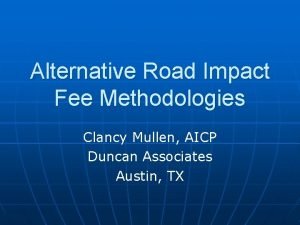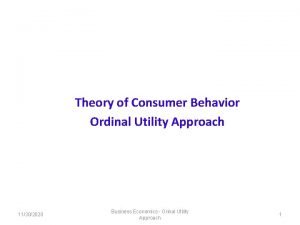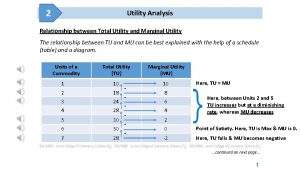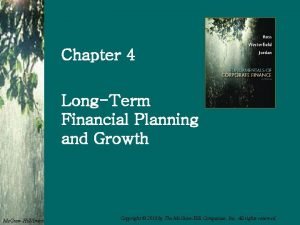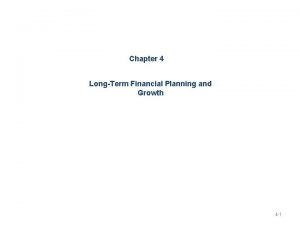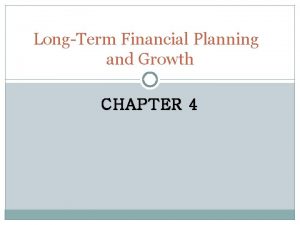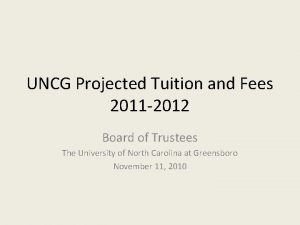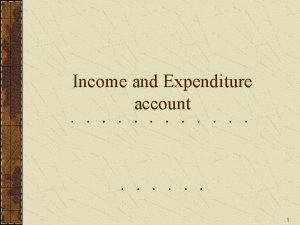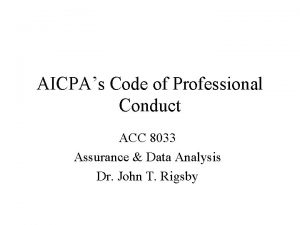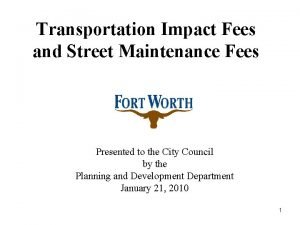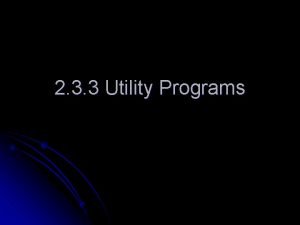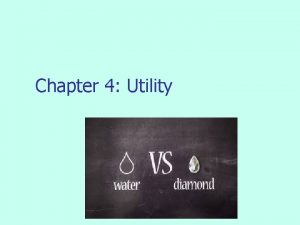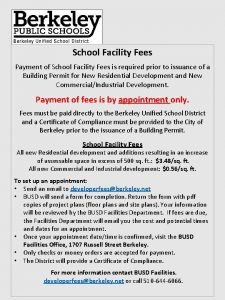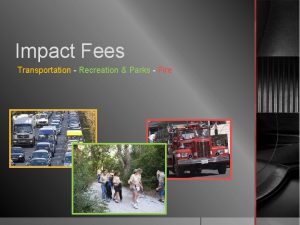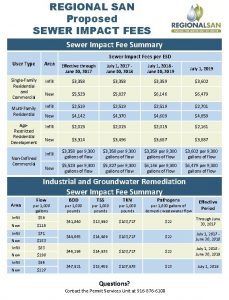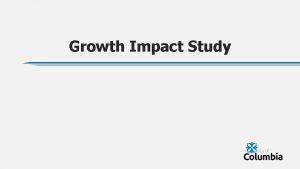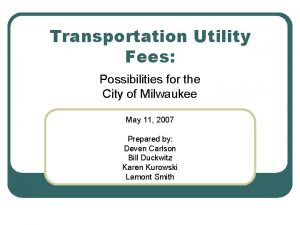PLANNING FOR GROWTH UTILITY IMPACT FEES AND EVALUATING










































- Slides: 42

PLANNING FOR GROWTH UTILITY IMPACT FEES AND EVALUATING REVENUE SUFFICIENCY

DISCUSSION TOPICS • Impact Fees for Water and Wastewater • History of Impact Fees in Florida • Objectives, Criteria, and Methods to Develop Water and Wastewater Impact Fees in Florida • Implementing / Updating Water and Wastewater Impact Fees • Evaluating Sufficiency of Utility Rates • • What is Revenue Sufficiency? Utility Assets and Capital Planning Operating and Maintenance Expenses Rates and Revenue Sources Financial Policies and Rate Covenants Financial and Management Planning and Reporting Public Understanding and Support 2

WHAT IS AN IMPACT FEE? • Fee or Charge Applied to New Development to Recover the Pro-rata Share of Infrastructure Built to Serve Growth • Also Referred to as Connection Fees, Capacity Fees, Capital Facilities Fees, Capital Recovery Fees, Development Fees, etc. • Fees Not Intended to Recover the Cost of Physical Connection (Water Main Tap, Meter Set, etc. ) • Fees Should Not be Used to Fund Deficiencies in Capital Needs or Operating Expenses • Fees May Only be Used to Provide Funding for System Expansions – Related to New Growth 3

HISTORY • Impact Fees Became Prominent in Florida in the 1970 s Because of the Need to Fund Infrastructure as a Result of Rapid Growth Without Burdening Existing Residents • Impact Fees have Generated Controversy and were Challenged, Especially in the Cases of: • Janis Development Corp. v. City of Sunrise (1973) (FL) • Venditti-Siravo, Inc. v. City of Hollywood (1973) (FL) • Contractors and Builders Association of Pinellas Authority v. The Authority of Dunedin, Florida (1976) (FL) 4

CONTRACTORS AND BUILDERS ASSOCIATION OF PINELLAS AUTHORITY V. THE AUTHORITY OF DUNEDIN, FLORIDA (1976) • City – Implemented Ordinance to Raise Impact Fees to $700 to Deal with Growth • Contractors – Filed Suit Claiming the Impact Fee was a Tax and Requested Refund • City – Issued New Ordinances Restricting Funds to System Specific Purposes • Court – Ruled that Impact Fee was Not a Tax “That the proceeds derived from the $700 Fee are earmarked by the City for capital improvements to the system as a whole” • Primary Issue – Contractors Wanted More Specificity About Impact Fees 5

FLORIDA IMPACT FEE ACT • Led to the Establishment of Statute 163. 31801 “Florida Impact Fee Act” • Recognizes Impact Fees as an Important Source of Revenues for Local Government to Use in Funding on Infrastructure Necessitated by Growth • Requires Calculation of Impact Fee be Based on Most Recent and Localized Data • Requires Accounting of Collections and Expenditures in Separate Fund • Limits Administrative Charges to Actual Cost • Requires a 90 -Day Notice Requirement for New or Increased Fees • Requires Annual Affidavit to Auditor General Confirming Compliance • Act has been Amended from Time to Time, Most Recently in 2011 6

CURRENT LEGISLATION • Currently, There are Bills in Both the House and Senate to Amend the Florida Impact Fee Act • CS/SB 324 (Young) and CS/CS/HB 697 (Miller) • Original Purpose was to Define Timing of Impact Fee Collects (No Collection Prior to Issuance of Building Permit) • Current Bill Includes Stronger Language and Minimum Requirements • Stronger Language to Define Minimum Requirements (“Must”, “At A Minimum”) • Adds Rational Nexus Test in Fee Calculation • Use for Debt Payments Prohibited Unless Expenditure is Connected Growth 7

FLORIDA IMPACT FEE ACT – COMPLIANCE • Fair Share Concept • Monies Collected from Impact Fees Should Only be Used for Expenditures that are Attributable to New Growth • Dual Rational Nexus Test 1. Fees are Valid when a Reasonable Impact or Rationale Exists Between the Anticipated Need for the Capital Facilities and the Growth in Population 2. Fees are Valid when a Reasonable Association, or Rational Nexus, Exists Between the Expenditure of the Impact Fee Proceeds and the Benefits Accruing to the Growth from the Use of the Proceeds 8

TIMING IS EVERYTHING • Impact Fees are “Link” Between Customer and Assets • Systems Must be Built Prior to Customer Connections • Requires Major Upfront Investment • Debt – Financial Risk, Existing Rate Payer Funded, if Debt Defeased Prior to Full Recovery Issue – Potential – Stranded Impact Fees) 9

TIMING IS EVERYTHING (cont’d. ) $ 60 Millions $ 50 System Expansion Treatment. Plant Treatment Construction $ 40 Maintenance $ 30 $ 20 $ 10 $0 5 10 15 20 25 Years 30 35 40 45 Infrastructure 10

INITIAL INFRASTRUCTURE INVESTMENT • Major Initial Investment • Potential Funding Sources of New Utility • Cost Free Capital – Contributions from Customers, General Fund, and/or Developers • Property Assessment to Large Land Area • Debt Financing 11

COST FREE CAPITAL Positives • “Cost Free” to Enterprise Fund • Typically Funding Linked Directly to Asset to Provide Service • Best Match of Asset to Customer • No Initial Capital Investment in Monthly User Rates • No Financing/Interest Costs • Strong Net Position – Enhanced Ability to Maintain (Funding of Depreciation / Reinvestment) Negatives • Not “Cost Free” to Customer • Property Tax Assessment • New Home Price • SPLOST (Sales Tax) (Georgia) • No Capacity Planning – Only Funding for Current Need • Customers Must Pay Prior to Receiving Service • First Customer Pays Highest Cost – Future Customer Receives Subsidized Service 12

DEBT FINANCING Positives Negatives • Utility Controlled Financing • Additional Financing Costs • Capacity Planning • Annual Interest Expense • Control of Purchase (Quality) • Potential Affordability Issues • Rational Nexus – Payment Links • Compliance Requirements Asset to Rate Payer • Customer would Pay for Capacity in Rates (Debt Component) • Burdensome to Net Position (Reduced Ability to Improve / Fund Depreciation and Reinvestment) 13

WHICH IS BEST? No Perfect Funding Mechanism • Cost Free Capital Only to Utility (Cost Incurred Elsewhere) • Debt Increases Annual Revenue Requirements • Neither Scenario Fully Limits Impacts to Existing Rate Payers • No Perfect Scenario Exists in the Real World Each Municipality is Different and Requires a Personalized Plan to Meet the Needs of Its Customers and System 14

IMPACT FEE CALCULATION Impact Fees in Their Most Basic Form are Unit Cost Calculation Localized Assets / Capacity = Cost per Unit (Gallon) Cost per Gallon × Level of Service = Impact Fee • Localized Assets = Infrastructure to Serve Growth • Capacity = Total Reliable System Capacity • Level of Service = Estimated Demand for One Customer (Referred to as Equivalent Residential Connection “ERC”) 15

MOST RECENT AND LOCALIZED DATA – WHAT SHOULD AND SHOULDN’T BE INCLUDED? Included • Assets that Benefit All Users • Water and Sewer Treatment Plants Excluded • Donated Assets – Developer Contributions • Assets Funded From Other • Wells Sources • Wastewater Disposal Facilities • Meters • Major Water and Sewer Mains • Vehicles (Moving Water/Sewer from Plant to Neighborhood) • Major Pump/Lift Stations • Long Service Lives • Major Expansions/Construction • Fire Hydrants • Other Externally-Funded Assets • Grants • Assets with Short Service Lives 16

IMPACT FEE DETERMINATION – LOCALIZED DATA Things to Consider when Establishing Most Recent and Localized Data: • Standard Method – Cost of Next Increment of Capacity – Typically Highest Cost • Used when Existing Infrastructure has No Additional Capacity • Buy-In Method – Cost of Existing Capacity – Typically Lowest Unit Cost • Used when Infrastructure has Excessive Capacity • Hybrid Method – Blending Standard and Buy-In Methods • Most Commonly-Used Approach • Growth Receives Benefit of Historical Costs • Recognizes Higher Cost of Future Capacity • Promotes “One System” Concept 17

TIMING IS EVERYTHING $ 60 Millions $ 50 System Expansion Treatment. Plant Treatment Construction $ 40 Maintenance $ 30 $ 20 $ 10 $0 5 10 15 20 25 30 35 40 45 Years Infrastructure Total Impact Fees Collections 18

TIMING IS EVERYTHING (cont’d. ) $ 60 Millions $ 50 System Expansion Treatment. Plant Treatment Construction $ 40 Maintenance $ 30 $ 20 $ 10 $0 Infrastructure 5 10 15 20 Total Impact Fees Collections 25 Years 30 35 40 45 Impact Fees 19

OTHER RELATED FEES Other Fees to Consider when Evaluating Impact Fees: 1. Connection or Tap-in Charges = Fee for the Physical Connection, Meter, Box, etc. 2. A. G. R. F. = Allowance for Funds Prudently Invested – Fee to Recover Carrying Costs on Investment (Interest Expense) 3. Customer Deposits – Equal to Potential Charges Incurred Before Disconnection 20

QUESTIONS AND DISCUSSIONS 21

EVALUATING UTILITY RATE SUFFICIENCY

DISCUSSION TOPICS • Evaluating Sufficiency of Utility Rates • What is Revenue Sufficiency? • Utility Assets and Capital Planning • Operating and Maintenance Expenses • Financial Policies and Rate Covenants • Rates and Revenue Sources • Financial and Management Planning and Reporting • Public Understanding and Support 23

GOVERNMENTAL ACCOUNTING STANDARDS BOARD “Enterprise funds should be used to account for operations that are financed and operated in a manner similar to private business—where the intent of the governing body is that costs of providing services to the general public on a continuing basis be financed or recovered primarily through user charges. ” 24

WHAT IS REVENUE SUFFICIENCY? • Producing Revenues that are Sufficient to Meet the Annual Funding Requirements for the Enterprise Fund • Identifying Funding Requirements – Capital Reinvestment, Personnel Needs, Operating Expenses, Debt Service Requirements, Reserve Targets • Net Revenue Requirements = Annual Funding Requirements Less Other Revenues (Amount Required to be Funded from Monthly User Rate Revenues) 25

UTILITY ASSETS AND CONDITION • Capital Plan Major Driver in Finance Plan and Level of Rates Charged for Service • Problem Engineering and Finance may have Different Goals and Objectives • Engineers can Always Identify Projects — Need Always Seems Immediate • May Result in “Unintended Consequences” • • • Appropriated Funds that are Not Spent Competition for Funds may Result in Unneeded Outside Financing “Lumpy” Capital Spending Plan High Cash Balances / may be Viewed Negatively Rates Artificially Increased 26

UTILITY ASSETS AND CONDITION (cont’d. ) • Funding is Limited — Must Establish Priorities in Capital Planning to Match Funds • Capital Planning Strategy • Capital Project Prioritization is the Most Critical in Planning Process • Develop Systematic Approach to Capital Planning • Provides Flexibility in Capital Planning Efforts • Assists in Making Sound Business Decisions • Identifies which Projects to Defer / Advance • Based on Market Conditions and Available Funds 27

Benefit CAPITAL PLANNING – PRIORITIZATION PROCESS Cost • • Identify the Criteria and Weights for Ranking of Projects Develop Performance Scales / Benefits for Each Criteria Develop Prioritization Model Economic Evaluation (Highest Return for Investment) 28

OPERATING AND MAINTENANCE EXPENSES • May Account for 50% - 75% of Annual Funding Requirements • Primary Components: • • Salaries and Benefits Power and Chemicals Professional / Contractual Services Repairs and Maintenance • Should Review Cost Relationships / Benchmark • Inflation Adjusted Trend Analysis • Compare to the Industry • Identify Improvements 29

FINANCIAL POLICIES AND BOND RESOLUTION PROVISIONS / RATE COVENANT • Primary Doctrine for Utility Business Process • Policies and Covenants Should Promote Stability / Creditworthiness • Establishes Minimum Financial Margins • Liquidity (Operating / Capital Reserves) • Debt Service Coverage and Debt Affordability • Cash Flow and Rate Covenants • Provide Management Guidance to Meet Business Objectives • Higher-Rated Utilities Set Goals that Exceed Minimum Financial Margins 30

FITCH RATINGS UTILITY GUIDELINES “For utilities in the most stable operating environments with a suitably diverse and healthy service area economy, 1. 5 x annual coverage, with consistently maintained unrestricted financial liquidity of at least 90 days of operating revenues, could be sufficient for ‘AA-’ or higher ratings. For utilities with substantial growth, compliance demands, or significant annual volatility in revenues or expenditures, greater financial flexibility may be necessary. ” 31

FINANCIAL POLICIES – RESERVE BALANCE POLICIES • Utilities Considered as Good Credit have Strong Reserve Balances and Policies • Operating Reserves • Repair and Replacement (Capital) Reserves • Rate Stabilization Reserves • Purpose — Reduce Volatility during Any Particular Fiscal Year • Reserve Balances are Cumulative — Funds Limited for Specific Purposes 32

FINANCIAL POLICIES – RESERVE BALANCE POLICIES (cont’d. ) Operating Reserves • Utilities Considered as Good Credit have Strong Reserve Balances and Policies • Operating Reserves • Repair and Replacement (Capital) Reserves • Rate Stabilization Reserves • Purpose — Reduce Volatility during Any Particular Fiscal Year • Reserve Balances are Cumulative — Funds Limited for Specific Purposes Capital Reserves • Repair and Replacement Funds • Purpose — Provide Funds for Capital Reinvestment • Allowance for Emergencies / Changes in Capital Priority • Average Balance Depends on: • Capital Investment Requirements and Remaining Service Life of Plant • Magnitude of Periodic Expenditures (e. g. , Membrane Replacement) 33

BOND RESOLUTION AND RATE COVENANTS • Absent Reserve Policy, Bond Resolution the Primary Financial Document • Flow of Funds • Minimum Deposit Requirements • Rate Covenant • Other Provisions • Sale of System Assets • Planning and Oversight 34

NET REVENUE REQUIREMENTS Revenue Requirements • Operating and Maintenance Expenses • Capital Funding Needs • Debt Service and Coverage Requirements • Policy Objectives (Meeting Reserve Targets) Less Other Revenues = Net Revenue Requirements = To be Funded from Monthly User Rates 35

OTHER REVENUE SOURCES • Charges to New Development – Recover Cost of Carry of Holding Capacity • • • In Addition to Impact Fee Interest Cost / Fixed Operating Cost Can be Linked to Developer Agreement Line Maintenance Fees / Other Specific Cost Recovery Mechanisms Goal = Make Unconnected Customers Responsible for Economic Impacts • Miscellaneous Fees – Disconnects, Meter Tests, After Hours Services • Interest Income • Reclaimed Water – Finite Resource Huge Potential Growth 36

RATE REVENUES – CONSIDERATIONS • To Improve Revenue Stability • Increase Fixed Cost Recovery Through Base Charges • “Readiness-to-Serve” Principle • Large Meter Sizes are Issue • Owner vs. Tenant • Adopt Price Index / Pass-Through Adjustment Charges • Smaller Incremental Increases • Maintain Operating Margins • Must Understand Customer Demographics • Bill Frequency — Where is Water Used? 37

FINANCIAL / MANAGEMENT PLANNING AND REPORTING Highest Rated Utilities • Exhibit Practices that Maximize Stability by Planning • Anticipate Future Regulatory and Growth Demands • Reliably Implement Steady Rate Increases Over Time • Have Liquidity to Meet Unexpected Sales Shortfalls / Emergencies Financial Management Key To • Highly-Rated Utility Credit • Long-Term Financial Forecasting • Considers Growth in Demand • Changes in Rates / Revenues • Infrastructure Renovation and Needs • Policies Ensure Appropriate Financial Margins • Financial Monitoring Systems • Limited Exposure to Financial Operations of General Government • Policies Adopted to Limit Scope and Growth 38

FINANCIAL PLANNING AND FORECASTING • Key is to Set Targets and Follow Plan • Prepare 5 - to 10 -Year Financial Plan • Addresses All Aspects of Business Model • Make Adjustments as Conditions Change 39

PUBLIC UNDERSTANDING AND SUPPORT • Must Communicate with Stakeholders • Decision-Makers • State of the Utility Report Prior to Budget Process • Show Decision-Makers Facilities — Tour or “Bring it to Them” • Involve the Public in Community Programs Where Possible • Rating Agencies and Financial Community • Provide Annual Update (Rating Agency Package) • Illustrate the Plan 40

QUESTIONS AND DISCUSSIONS 41

• For additional information and questions regarding this presentation, please contact: Ryan Smith Public Resources Management Group, Inc. 341 North Maitland Avenue, Suite 300 Maitland, FL 32751 Phone: 407 -628 -2600 Email: RSmith@PRMGinc. com Website: www. PRMGinc. com 42
 Achd impact fees
Achd impact fees Cardinal utility approach
Cardinal utility approach Relation between marginal utility and total utility
Relation between marginal utility and total utility Growth analysis definition
Growth analysis definition Pith
Pith Primary growth and secondary growth in plants
Primary growth and secondary growth in plants Chapter 35 plant structure growth and development
Chapter 35 plant structure growth and development Carothers equation
Carothers equation Geometric vs exponential growth
Geometric vs exponential growth Neoclassical growth theory vs. endogenous growth theory
Neoclassical growth theory vs. endogenous growth theory Organic vs inorganic growth
Organic vs inorganic growth Long term financial planning and growth chapter 4
Long term financial planning and growth chapter 4 Internal growth rate formula
Internal growth rate formula Long term financial planning and growth
Long term financial planning and growth Portland state university tuition
Portland state university tuition Tuition at uncg
Tuition at uncg Donation in income and expenditure account
Donation in income and expenditure account Rule 503 commissions and referral fees
Rule 503 commissions and referral fees Cushing & dolan
Cushing & dolan Cushing and dolan fees
Cushing and dolan fees Formuö
Formuö Novell typiska drag
Novell typiska drag Tack för att ni lyssnade bild
Tack för att ni lyssnade bild Vad står k.r.å.k.a.n för
Vad står k.r.å.k.a.n för Varför kallas perioden 1918-1939 för mellankrigstiden
Varför kallas perioden 1918-1939 för mellankrigstiden En lathund för arbete med kontinuitetshantering
En lathund för arbete med kontinuitetshantering Underlag för särskild löneskatt på pensionskostnader
Underlag för särskild löneskatt på pensionskostnader Tidbok yrkesförare
Tidbok yrkesförare A gastrica
A gastrica Förklara densitet för barn
Förklara densitet för barn Datorkunskap för nybörjare
Datorkunskap för nybörjare Tack för att ni lyssnade bild
Tack för att ni lyssnade bild Debatt mall
Debatt mall För och nackdelar med firo
För och nackdelar med firo Nyckelkompetenser för livslångt lärande
Nyckelkompetenser för livslångt lärande Påbyggnader för flakfordon
Påbyggnader för flakfordon Tryck formel
Tryck formel Svenskt ramverk för digital samverkan
Svenskt ramverk för digital samverkan Jag har nigit för nymånens skära
Jag har nigit för nymånens skära Presentera för publik crossboss
Presentera för publik crossboss Jiddisch
Jiddisch Kanaans land
Kanaans land Treserva lathund
Treserva lathund
